Monitoring the Illegal Killing of Elephants
MIKE’s Purpose
Participation in MIKE may not mean Support for it
History and Background
Organization and Structure
MIKE Sites
Data Collection
PIKE
About MIKE’s numbers: Senegal’s Elephant
South Africa and Zimbabwe
Nigeria
“The Quality of Data Varies Significantly . . .”
The Disconnect
MIKE goes global: MIKES
African elephant range States
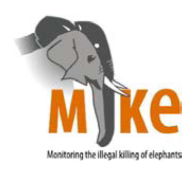 The name is as self-explanatory as it gets. Explaining the monitoring and the rest of it, though, is a muddy line between “ideally” and “in reality” or between it is supposed to be doing and what it does.
The name is as self-explanatory as it gets. Explaining the monitoring and the rest of it, though, is a muddy line between “ideally” and “in reality” or between it is supposed to be doing and what it does.
The MIKE program was set up by CITES in the early 2000s to provide itself with regularly updated information about how the elephant populations are faring in order to help it make better decisions. The program includes both Africa and Asia. I focus exclusively on Africa here.
MIKE’s Purpose
The program’s “specific objectives” are:
“a) to measure levels and trends in the illegal hunting of elephants;
b) to determine changes in these trends over time; and
c) to determine the factors causing or associated with such changes, and to try and assess . . . to what extent observed trends are a result of any decisions taken by . . . CITES.”
 The “factors” thought to be influencing poaching “levels and trends” include global ones like rising Chinese personal consumption expenditures and the price of Siberian mammoth ivory.
The “factors” thought to be influencing poaching “levels and trends” include global ones like rising Chinese personal consumption expenditures and the price of Siberian mammoth ivory.
The “most important national-level [factor bearing on] elephant poaching.” continues to be the quality of governance.
Factors on the local level are issues such as poverty, “land tenure systems,” military or civil unrest, “cross-border incursions,” the fitness of local law enforcement, and “rainfall anomalies.”
The hope is that “by providing reliable information,” MIKE’s data and analysis “fosters dialogue among Parties [the countries that are part of CITES] and facilitates decision-making . . . regarding the protected status of elephants.” Loudly lamenting the lack of quality information has been a favorite delaying tactic of opponents of popular courses of action. By providing its own information, CITES hoped to end this tactic’s use, at least, where the elephant is concerned. I am not sure it has succeeded because . . .
top
Participation in MIKE may not mean Support for it
To assess poaching levels, MIKE relies on data voluntarily reported to it by countries which participate in the program. Independent verification of the data is often politically – even dangerously – difficult to obtain. If a participating country’s government may be abetting poaching and ivory smuggling, how reliable can its MIKE data be if MIKE’s purpose is to document and publicize its poaching levels?
As of early 2015, 30 African countries are participating in the MIKE program. The participating governments control the MIKE activities within their borders as well as the data that leaves them. It’s a bit like each participating government gets a MIKE franchise for its country. Unlike a regular franchising arrangement, however, the participating governments get paid every year for being in the MIKE program: money, jobs, knowhow, premises and equipment. Unlike the Starbucks bosses in Seattle, however, the MIKE execs in Switzerland have little control over how the franchisee governments run things especially in terms of gathering and reporting quality data.
Several participants have uncooperative (don’t explain, no details) and unreliable monitoring practices. (examples below) Several are among the countries whose governments CITES has determined to be “most heavily implicated in the illegal trade in ivory.” Obviously, some are in both camps. Indeed, if a corrupt government has MIKE’s monitoring resources available to it, it’s probably pretty good at finding elephants and poaching them.
At the other end of the spectrum, there’s one or two participating countries that may not have any elephants to monitor. They still get their MIKE benefits for participating though.
All told, about half of the MIKE participants might well have a negative – even obstructive – attitude towards the program even as they derive goodwill and benefit financially from participation.
(For more on this, see “The Disconnect” below)
top
History and Background
The MIKE program was proposed as part of the contentious CITES decision in 1997 (Decisions 10.1 and 10.2) to downlist the elephants in Botswana, Namibia and Zimbabwe from Appendix 1 with its most restrictive protections back to the looser Appendix 2. The 3 countries were also permitted to sell part of their raw ivory stocks to Japan. (More contentious sales to China were agreed to a few years later.)
The condition for this deal was that CITES would create programs to monitor poaching and illegal ivory trading across Africa. (Asia, too, but there you’re on your own.) The information generated would be used to determine how well the CITES’ countries, such as Botswana, Namibia and Zimbabwe, were implementing CITES’ decisions.
MIKE is the poaching monitoring part of the condition and began its work in 2001. (ETIS and TRAFFIC handle the ivory trafficking part.) While not all elephant range States participate in the MIKE program (a list of who’s who is below), MIKE’s remit is to identify and estimate elephant poaching trends and levels across all Africa.
top
Organization and Structure
MIKE has its own staff, but the program is dependent on the work and cooperation of many unrelated actors including scientists, NGO staffers and officials from inter-governmental agencies and from the many government wildlife authorities across Africa. MIKE is part of CITES and does not have its own dedicated website, but it works closely with IUCN (International Union for the Conservation of Nature). A recent IUCN online job posting was for a full-time MIKE staff job though the winning applicant would be hired and employed by IUCN.
MIKE’s finances and organizational chart do not appear to be public. (As of July, 2015, CITES’ most recent available financial annual report is that of 2009.)
As you can see from the map (click to make larger; map info is below), MIKE divides the Africa elephant range into 4 subregions, equal in size and unequal in elephants: Southern Africa with over half the continent’s elephants, the Eastern subregion with maybe 30%, the Central very roughly 15% and the Western with under 2%. (A list of who’s who and where is below.)
top
MIKE Sites
Elephants once moved broadly across much of sub-Saharan African. While elephants are still found across a vast area of 800 million acres (or 1.2 million sq miles), their ranges are no longer continuous, but broken up into innumerable large and small ranges (see green and tan areas on map above). In MIKE’s Southern and Eastern subregions, the ranges are larger including a few the size of Switzerland. In the Western subregion, they are mostly atomized specks. Within these ranges, MIKE has designated areas or sites of varying sizes (see yellow areas on map) to represent a fair sample of the whole elephant population.
Together, these MIKE sites “hold an estimated 30 to 40% of the elephant population.” That percentage varies dramatically site to site. As of early 2015, there are 60 MIKE sites. The 3 sites in Senegal and Togo had virtually no elephants based on the last survey (2012.) Togo reported 4 elephants spread over its 2 sites. More on Senegal’s only elephant below.
The rest of the 450,000 elephants thought to be left in Africa are monitored by the other 57 MIKE sites. However, I can’t confidently tell you the elephant populations in a dozen or so of these 57 sites since the recent data provided by MIKE is based on little or no information. (see below)
These 60 sites are what MIKE monitors to estimate the levels and trends of the illegal killing of elephants across all of Africa. I’ve come to feel a little foolish and helpless relying on MIKE’s information elsewhere on this blog, but CITES and the rest of us all do and seemingly without question.
For logistical reasons, MIKE sites are all in “protected areas,” which makes monitoring more difficult. That’s because, according to the IUCN most “elephants live outside or move between the boundaries of protected areas where few surveys are undertaken. Elephant numbers in these unprotected areas may be based on pure guesswork. The seasonal and cross-border movements of elephants . . . may result in either double-counting or undercounting . . . ”
top
Data Collection
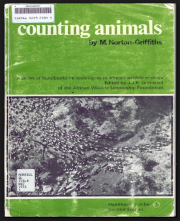
Michael Norton-Griffiths 1978 bible for counting guidelines
MIKE data about dead elephants, killed illegally or not, comes “from ranger patrols and other sources [such as locals, safari guides, tourists and researchers] in designated MIKE sites. When an elephant carcass is found, rangers identify the cause of death and other details and fill in standardized carcass forms that are then submitted to” the MIKE Site officer.
“Ideally,” CITES noted in 2013, “data on elephant range and population would be collected at frequent intervals by an authorized national wildlife authority, which would employ well-trained staff and standardized methods for collecting the data.
In reality, however, data collection is often done by several different agencies using a variety of different methods determined by available funds and current opinion.” (More about that reality below)
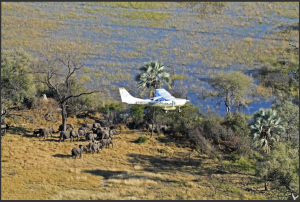
Observers in a Cessna add up the numbers of elephants in transect flights over northern Botswana’s Okavango Delta as part of an 18-country survey called the Great Elephant Census – Photograph by Kelly Landen
Site data is passed up to the National MIKE officer who submits it to the subregion’s board. All the data finds its way to the MIKE Central Coordinating Unit in Nairobi where it is uploaded to IUCN’s Elephant Database servers in Switzerland. At the end of 2014, the database had more than 13,500 carcass records. (an early draft of the carcass report form is on another page.)
MIKE staff also work into their calculations reports of the disappearance of elephants long known to locals or elephant researchers. Are they to be presumed killed or alive, but dispersed?
I believe that MIKE’s numbers include bushmeat poaching, unlicensed sport hunting and the unauthorized killing of destructive or “nuisance” elephants that may have destroyed crops or damaged villages. Most illegally killed elephants, however, have been poached for their tusks.
MIKE counts living elephants by various methods, both direct (such as aerial surveys) and indirect (such as dung surveys – the amount found indicates the number of elephants around.) As part of its analysis, MIKE staff considers “other qualitative data” such as “changes in the profile of illegal hunter,” for instance, poor locals poaching on their own to survive giving way to poachers hired by organized crime.
top
PIKE
MIKE’s well-known, media-friendly measure of poaching intensity in an area is called PIKE (Proportion of Illegally Killed Elephants). You take the number of illegally killed elephant carcasses found in an area (MIKE site, sub-region, Africa) in one year and divide it by the total number of elephant carcasses found in the same area and year. In 2011, for all of Africa, PIKE was over .6. That is to say, more than 60% of all the elephants that died in 2011 were probably killed illegally. PIKE has declined and leveled off, but stayed unsustainably high. It was above .5 as of year-end 2014.
top
About MIKE’s numbers: Senegal’s Elephant
(back to Participation in MIKE)
(back to Data Collection)
(back to Aer States)
(back to Senegal’s only elephant)
The process for designating a MIKE site is  complex with scientific and political criteria considered. It’s a mix that creates some anomalies. Each “elephant range State” that participates in the MIKE program gets at least one MIKE site.
complex with scientific and political criteria considered. It’s a mix that creates some anomalies. Each “elephant range State” that participates in the MIKE program gets at least one MIKE site.
Senegal’s MIKE site is the
Niokolo-Koba National Park (about the size of Rhode Island or 1,200 squ miles) in the southwest. In 2007, 1 elephant was definitely thought to be living there, and there was enough dung around to speculate on another 9.

Senegal’s MIKE site (circled) and neighboring sites. source: Elephant Database
For the 2012 update, 2007’s numbers were simply repeated since “[t]here were no new estimates available.” The 1 “Definite” elephant stayed put in the “Definite” column though good science or conscience might have recommended moving it to the “Probably” or even the “Possible” column.
The footnotes clearly explain this re-use (and that 2007’s numbers, at least, were based on then-current data.) They don’t explain the point of repeating the old numbers as opposed to leaving 2012 blank which might highlight – if subtly – Senegal’s lack of diligence.
top
South Africa and Zimbabwe
While several countries ably comply with MIKE site data demands, many like Senegal do not. The Southern subregion provides examples of both in the Elephant Database’s 2012 numbers.
South Africa’s rigorous, up-to-date herd surveys showed a healthy increase in their elephant numbers from the previous report in 2007. I’d bet on a positive correlation between “rigorous, up-to-date surveys” and “healthy increase.”

Elephants along the Olifant River – Kruger Natl Park, South Africa
On the other hand, half the surveys that Zimbabwe submitted – or rather, resubmitted – for 2012 were over 10 years old. “Very few new surveys have been conducted since 2007.” Not surprisingly, Zimbabwe’s 100,000 elephant population looked to be pretty stable from 2007 to 2012. Again, the footnotes are all clear about the 2012 numbers’ lack of freshness. In an apparent fit of pique, the Elephant Database analysts did move a third of Zimbabwe’s elephants from the “Definite” column in 2007 over to “Speculative – Other Guesses” in 2012. Elephant sales only began in 2014. An “Exports” column may make sense for 2017.
Zimbabwe’s data quality is not the exception. CITES and IUCN reported in 2013 that “Overall data reliability at the continental level has declined as many important populations have not been surveyed for over ten years.”
top
Nigeria
As a final example, the Elephant Database reported that Nigeria in the Western subregion possibly had 800 elephants in 2012, but the Database analysts footnote that this number is based on “no reliable information.” 5 other countries with 11 MIKE sites are in this camp of no or little reliable information. (Cameroon, Chad, the Democratic Republic of Congo, Liberia and Togo)
top
“The Quality of Data Varies Significantly . . .”
With the paying jobs of MIKE Site officers and National MIKE officers – as well as budgets for staff, equipment and vehicles – in the patronage of various government officials, these 15 MIKE sites seem like pocket boroughs in search of a Reform Act. Meanwhile, when MIKE says their elephant numbers are based on data from 60 sites, we understand them to mean 45 or less.

The Disconnect
(back to Participation in MIKE)
The disconnect is this:
First, the data that MIKE relies on is self-reported by the wildlife officials of each participating country on a purely voluntary basis. “And if MIKE or Traffic questions the numbers the governments give them,** they aren’t going to get anything, so they have to go along with them. Outsiders who ask too many questions or accuse the politicos in their host country of malfeasance run the risk of being thrown out, or even, . . . killed.”
Second, from the getgo, the participating African elephant range States (Aer States) have never kicked in much for MIKE’s expenses. MIKE has been largely underwritten by the European Union and by NGOs like Save the Elephants which do much of the research MIKE publishes. Most of the money is spent by – or in consultation with – the governments of Aer States.
Thus, with no consequences for providing no or poor data and with money (and goodwill) to be had for participating, a country’s officials who are indifferent to or actually abetting the poaching crisis have no qualms about joining MIKE.
There’s no consequences for MIKE’s credibility either apparently. As noted in the next section, “the majority of [MIKE’s] stakeholders” find both MIKE’s and the Elephant Database’s work “statistically robust, impartial and vital for decision making.”
Since, as shown above, MIKE will footnote away the irregularities of less than hard data, the wildlife and other government officials in a country with a poaching problem are unlikely to supply data that could be used to embarrass or even incriminate the country and those same officials.
It is not surprising that data quality is a concern where poaching may be high.
Again and again, MIKE points out the uncertainty of its numbers where poaching is thought to be most severe. “The quality of data varies significantly across subregions,” with that of its Central subregion being “particularly fraught.”
In 2014, MIKE conceded that “there has been a reduction in the overall reliability of data in Southern Africa and in parts of Eastern Africa.”
In the end, CITES tolerates “doubts about the accuracy of some of the data” and “generally very poor” reporting rates from certain countries while insisting that “their contribution in terms of data is crucial to informed decision-making by the CITES Parties.”
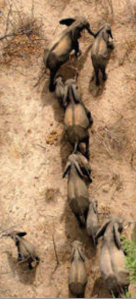
While I was trying to figure MIKE out, I read Alex Shoumatoff’s 2011 Vanity Fair article** about poaching. After taking MIKE to task for issues like those above, he asks Iain Douglas-Hamilton what he thinks.
Dr. Douglas-Hamilton is one of the most experienced, research-oriented and savvy of Africa’s elephant protectors. He helped design the MIKE system. He is a member of IUCN’s African Elephant Specialist Group that oversees the Elephant Database. The Samburu-Laikipia MIKE site in central Kenya, which his NGO, Save the Elephants, manages, “serves as a calibration for all other MIKE studies.” His Elephant Crisis Fund is all about getting a more concerted, united response from NGOs and governments across borders.
Shoumatoff writes that “Douglas-Hamilton, who is trying to make these institutions work—because without them there would be nothing at all—cautions against ‘throwing out the baby with the bathwater. Traffic [an NGO focused on monitoring ivory trade] and MIKE are the only ones who are making every attempt to get the correct figures.’”
Is he rebuking the author or is he an old man reminding himself that he has been doing everything humanly possible for 50 years?
top
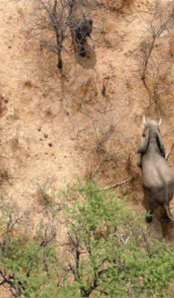 MIKE goes global: MIKES
MIKE goes global: MIKES
Minimising the Illegal Killing of Elephants and other Endangered Species
CITES and MIKE’s major funder, the European Union, consider MIKE data – for the most part – “statistically robust, impartial and vital for decision making.” (sources at end of section) Pleased, they have decided to rebrand the MIKE program as the MIKES project and expand its scope dramatically in 2 ways.
First, MIKE’s monitoring skills will be available to be applied worldwide to any endangered species in need of monitoring especially in the Caribbean and the Pacific. It will improve existing programs or set up new ones.
Second, MIKES will take on some kind of active role in “minimising the impact of poaching and the illegal trade” of targeted species and in the “[d]evelopment of protected area law enforcement. . .” In Africa, for instance, MIKES will provide “additional support for strengthening law enforcement capacity focused on” 8 MIKE sites.

With greater resources to spread around, MIKES might come upon a new species in the Niokolo-Koba: loxodonta Senegalis
The MIKES project began in late 2014 and will run through mid-2019. However, it seems likely to live on. The old MIKE “will be financed by . . . MIKES.” It also looks to take over much of what MIKE currently does. The 4.5 year budget is 13.7 million Euros, 90% of which is to be paid by the EU with CITES et al picking up the rest. While MIKES appears to have more resources to offer, the MIKES participants (same as the old MIKE participants) will have no skin in this game either.
The awkward retention of “Elephants” in the name suggests some kind of awkward compromise. I wonder how soon it is dropped.
MIKE did not seem to serve the elephants very well when they were the only focus and the elephant countries were in charge. It is hard to see how well the elephants will be served as one of many needy species and the elephant countries must share control and compete for funding.
source doc for this section
2nd source doc for this section
top
African elephant range States and adjacent non-elephant range States:
(return to History)
(return to Organization)
There are 42 countries within the 4 MIKE sub-regions (click to show map in a new tab.) According to CITES, 38 of these are African elephant range States (Aer States) though at least 3 probably have very few or no elephants. For instance, Sudan is still considered an Aer State despite the fact that all its elephant range went to South Sudan in the 2011 partition. (see map above) South Sudan was duly added to the list.
The thing is, the number and the phrase with its odd capitalization have political and financial significance. The Aer States are the authors of the 2010 “African Elephant Action Plan,” a wish list of aid they’d like to be given to fight poaching and ivory trading. They also are the hopeful beneficiaries of the as yet lightly funded “African Elephant Fund.”
Back to MIKE.
 As of early 2015, 30 countries participate in the MIKE program. At least one of these may have very few or no elephants.
As of early 2015, 30 countries participate in the MIKE program. At least one of these may have very few or no elephants.
Western sub-region MIKE participants: (11) Benin, Burkina Faso, Côte d’Ivoire, Ghana, Guinea, Liberia, Mali, Niger, Nigeria, Senegal (may have no elephants), Togo
Togo had around 100 elephants in 2012 and has 2 of the 60 MIKE sites. There are about 450,000 African elephants in total that these MIKE sites must monitor.
non-participants that may have some elephants: (2) Guinea-Bissau, Sierra Leone
non-participant with no elephants: (1) the Gambia
Central MIKE participants: (6) Cameroon, Central African Republic, Chad, Congo, Democratic Republic of the Congo, Gabon
non-participant that may have some elephants: (1) Equatorial Guinea
EG was a MIKE participant until 2012. I cannot find information on why it left MIKE or who picked up its MIKE site since there were 60 sites before and after EG’s departure. The latest Elephant Database estimate for EG is from 2007 for 20 elephants though this is based “no reliable information.” EG is still an Aer State.
Eastern MIKE participants: (6) Eritrea, Ethiopia, Kenya, Rwanda, Tanzania, Uganda
non-participant with elephants: (1) Burundi This is the only country that has elephants and is not considered an Aer State.
non-participants that may have some elephants: (2) Somalia, South Sudan
Somalia is still an Aer State even though it has virtually no range left (see map above), last estimate (2007) was 70 elephants based on a survey of the lowest quality.
non-participants with no elephants: (3) Djibouti, Somaliland, Sudan
Sudan is still an Aer State even though all old Sudan’s elephant range is now in South Sudan. It is still an Aer State.
Southern, MIKE participants: (7) Botswana, Malawi, Mozambique, Namibia, South Africa, Zambia, Zimbabwe
non-participant with elephants: (2) Angola, Swaziland
top
__________
NOTE on the Elephant Database: It is not clear to me how much of their data on MIKE participants is MIKE data and how much is from other sources. Thus, I cannot be sure that all the data quality issues I point out stem, in fact, from MIKE supplied data. However, because MIKE apparently does not publish its own numbers and seems to refer those interested in their numbers to the Elephant Database without qualification, I made no distinctions. The Elephant Database pre-dates MIKE. The MIKE participants adopted the Database as the “official repository” of MIKE data in 2002.
** recommended source
All green links take you to WordPress.com addresses. You’ll go to one of 3 places: another part of this page, to another page on the blog OR to a PDF I created and annotated of my source info. The web address of the original source is at the top of my PDF.
elephant bones image cropped from a photo by Donald Macauley (Flickr: IMG_4911) CC BY-SA 2.0, via Wikimedia Commons
photo of elephants from above is on Resource Mapping GIS There is no photographer credit.
map is from page 37, Elephants in the Dust**, a publication of CITES’ parent, UNEP (UN Environment Programme) and TRAFFIC, 2013. I have Photoshop’d the original map and removed some data for my purposes.
photo of Great Elephant Census by Kelly Landen, GEC’s Director/Program Manager. Image was found in a September 18 2014 post at Focusing on Wildlife
paint by numbers image is lifted from Elephant a Day blog where the original can be seen.
Kruger National Park image is in a 1/9/2014 story in the Inter’l Business Times Used under Creative Commons. The credit is poo-tee-weet. I am sorry there is no link to the photographer’s work to offer, but here is the Slaughterhouse 5 reference:

single elephant from above photograph is by Lian Pin Koh taken by his team’s experimental drone used through Creative Commons license (50/50 chance this is not looking down on Africa, but Asia.)
left, then center and finally right side of photo of elephants from above found on Resource Mapping GIS There is no photographer credit.
The stuffed pull toy is from a German historical toy site


